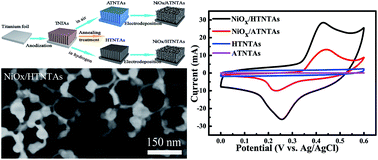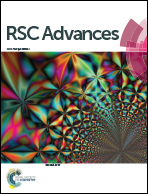Supercapacitive performance of hydrogenated TiO2 nanotube arrays decorated with nickel oxide nanoparticles†
Abstract
Highly ordered self-organized TiO2 nanotube arrays (TNTAs) could not only be used as current collectors, but also adopted as highly ion-accessible and charge transfer-channels for the construction of supercapacitors. In this paper, hydrogenated TNTAs were obtained and then nickel oxide (NiOx) nanoparticles were successfully deposited onto the inner surface and interface of HTNTAs through a cyclic voltammetry electrochemical deposition process (NiOx/HTNTAs). The FESEM images of the samples showed that the diameter of the NiOx nanoparticles ranged from 7 to 60 nm. The as-fabricated NiOx/HTNTAs exhibited an obviously pseudocapacitive performance with a specific capacitance of 689.28 F g−1 at a current density of 1.5 A g−1 and 91.9% of the initial capacitance remaining after 5000 charge/discharge cycles at a current density of 3 A g−1 in 1 M KOH. This work reveals a feasible and green method for the fabrication of TNTAs modified with electroactive metal oxide nanoparticles as functional electrode materials for supercapacitors.


 Please wait while we load your content...
Please wait while we load your content...